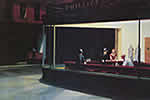"More of me comes out when I improvise." ~ Edward Hopper
Edward Hopper (1882-1967) was the first significant 20th century American painter and his unique works of bold realism continue to fascinate.
"What lives on in the painting is the personality of the painter," he explained.
With strong juxtapositions of color, Hopper was a silent witness who captured the emotions and familiar motifs of the big-city. His illumination of light created feelings of solitude and revealed the unexposed beauty of life.
"It is very well to copy what one sees," he explained. "It's much better to draw what one has retained in one's memory. It is a transformation in which imagination collaborates with memory."
Hopper was born in the small town of Nyack, New York, studied illustration and painting at the New York School of Art, and spent time in Paris, developing his style. He described his most famous work, Nighthawks (1942) as "a restaurant on Greenwich village where two streets meet."
"Nighthawks seems to be the way I think of a night street. I didn't see it as particularly lonely. I simplified the scene a great deal and made the restaurant bigger."
A big fan, director Alfred Hitchcock, modeled Norman Bates' house in the great film Psycho (1960) after Hopper's House By the Railroad (1925). Hopper insisted that his haunting paintings were not a commentary on contemporary life: "I am just trying to paint myself."
"No amount of skillful invention can replace the essential element of imagination," he believed.
More Art & Artists Quotations

